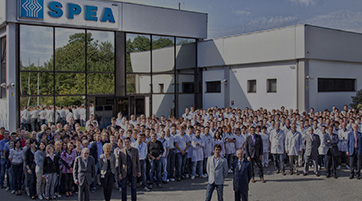Semiconductor probe card testing
Complete, automatic test, with component-level diagnostics
Semiconductor probe cards, used in wafer-level IC testing, are the contact interface between the semiconductor test equipment and the bonding pads of the devices under test.
Probe cards are normally mounted onto a wafer prober, and connected to the tester. A single defect in these circuit assemblies will affect the contact reliability, compromising the test results. For this reason, the probe card integrity must be verified before using it on the semiconductor test system, to be sure it is defect-free and capable of properly contacting and testing the semiconductor devices.
How can you test your probe cards?
Probe cards are often tested by running, on the same semiconductor tester they are going to be used on, a specific diagnostic procedure. Although it is quite common, this practice presents several disadvantages:
- A high cost of test, since an expensive semiconductor tester (normally running 24 hours a day) is used, interrupting its productivity
- Long diagnostic test development
- Inadequate diagnostic capability: the functional test performed on the semiconductor tester is not able to detect all possible defects on the probe card
- Long repair time: when a defect is detected, the tester is not able to provide a precise error message. The defective part is not identified, nor repair guidelines are provided: an expert test engineer has to make a deep, time-consuming analysis to repair the probe card
- Hidden faults are not detected: defects that do not influence directly the functionality of the probe card can create instability or malfunctioning in production
Direct probing of contactor pins
Basing on a full linear motion architecture with linear encoders on XYZ, SPEA flying probers are able to accurately and reliably contact the smallest probe card pins, meeting today’s miniaturization trends. Soft Touch Technology ensures that no mark is left on the pad surface, guaranteeing product integrity.
PCB and ceramic board probing
The capability of simultaneous probing at different height levels makes SPEA flying probers able to perform the continuity test between PCB and ceramic board, in addition to the complete parametric and functional test of the ceramic board after final assembly.
Easily fits all types of probe card
The large test area allows SPEA flying probers to fit any probe card with up to 1200x668mm size (47.2×26.3”), while the input conveyor module makes it easy to load the heaviest probe cards (up to 20Kg), that are automatically and effortlessly loaded into the test area.
Top vs. Bottom continuity test
SPEA flying probers are equipped with up to 4 top-side and 4 bottom-side moving heads, to test both sides of the probe card simultaneously allowing the verification of the nets continuity from top to bottom.
Advantages along the whole process
Test of fresh probe cards
SPEA flying probers can thoroughly test any type of probe card, accurately verifying the correct working and parameter values for each net and embedded component, in order to detect every process defect or component failure.
This is performed off-line, without needing to spend hours on the IC tester of destination, while releasing the probe card testing from the required presence of an expert engineer.
Testing the ceramic board allows the early detection of failures before the final assembly on the PCB. Precise diagnostic information is provided for every defect found, so that the expertise and time required to repair the probe card are greatly reduced.
Troubleshooting
When a probe card breaks down, SPEA flying probers simplify the repair process. It is enough to run the flying probe testing on the area that has shown defectiveness to get a precise diagnosis of the faulty parts, off-line, reducing to minutes the downtime of the IC tester while also minimizing the time needed to repair.
Test after repair
Also the post-repair verification, before sending back the probe card to the production floor, can be readily performed on the SPEA flying probers, getting a full test coverage to verify that the repair operation has been effective, and no other failure is present.
Automatic probe card handling
The probe card handling and loading operations into the test area can be completely automatic, with SPEA Board Handling Equipment. These modular units are the only automatic loaders on the market able to handle large probe cards directly from rack magazines.

